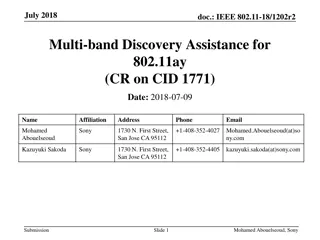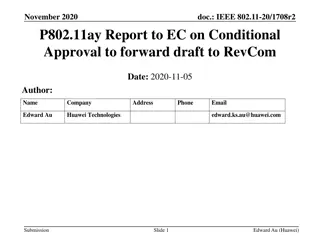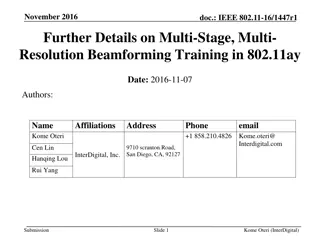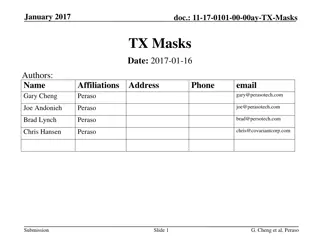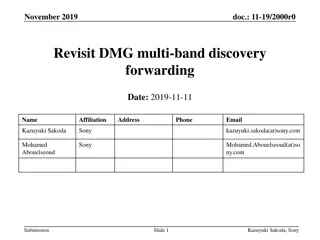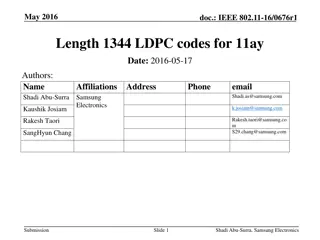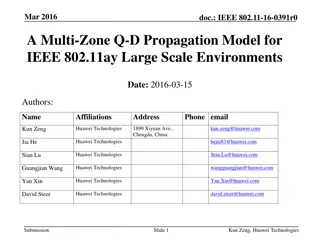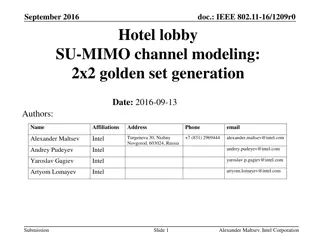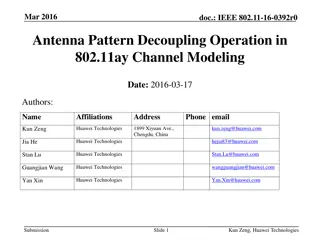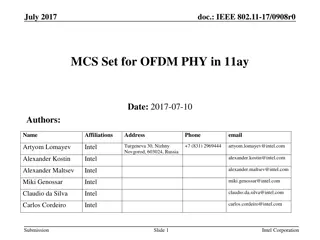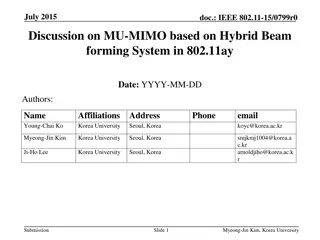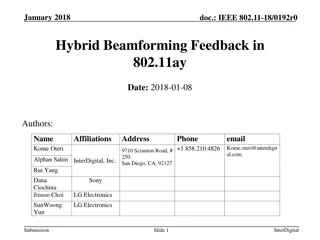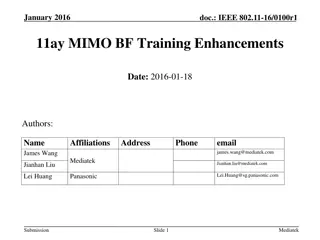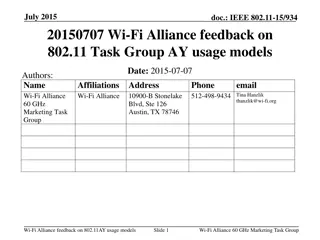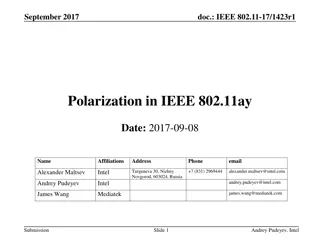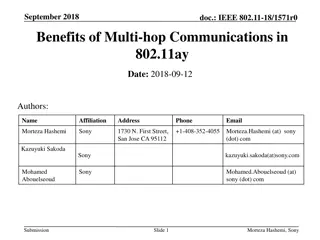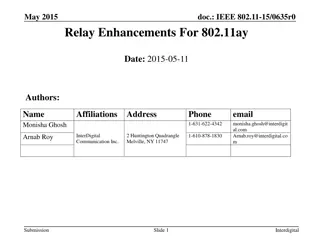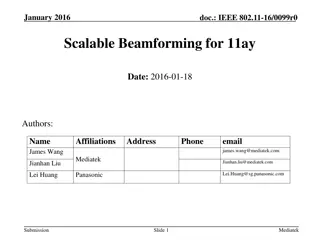Multi-band Discovery Assistance for IEEE 802.11ay Networks
This document discusses the implementation of multi-band discovery assistance for IEEE 802.11ay networks to improve robustness and reduce latency in consumer devices. It focuses on reducing overhead latency, enabling TDD channel access, and utilizing multi-band signaling for various network operatio
5 views • 10 slides
IEEE 802.11ay Report Submission to Executive Committee
Document providing a report to the IEEE 802 Executive Committee requesting conditional approval to forward the P802.11ay draft to RevCom. The submission includes details on SA ballot results, voter comments, unsatisfied comments, and resolutions. Edward Au from Huawei Technologies authored the repor
1 views • 8 slides
Enhancements in Multi-Stage Beamforming Training for IEEE 802.11ay
IEEE 802.11ay introduces improvements in beamforming training procedures for efficiency and MIMO support. The multi-stage, multi-resolution beamforming training framework enhances beamforming efficiency with high-resolution beams. The proposal includes a Sector Sweep frame and support for up to 2048
0 views • 19 slides
Multi-Stage, Multi-Resolution Beamforming Training for IEEE 802.11ay
In September 2016, a proposal was introduced to enhance the beamforming training procedures in IEEE 802.11ay for increased efficiency and MIMO support. The proposal suggests a multi-stage, multi-resolution beamforming training framework to improve efficiency in scenarios with high-resolution beams a
5 views • 11 slides
Proposal for Revised 802.11ay TX Masks in January 2017
Detailed presentation by Gary Cheng and team from Peraso on the revised proposal for 802.11ay TX Masks in January 2017. The submission covers aspects such as mask revisions for different channel bandwidths, corner frequency shifts, ACI levels, and PA distortion results under specific evaluation cond
1 views • 12 slides
Revisiting DMG Multi-Band Discovery Assistance for 802.11ay Networks
Presentation by Kazuyuki Sakoda from Sony proposing the extension of DMG multi-band discovery assistance in 802.11ay networks to improve neighbor device discovery beyond AP coverage. The focus is on enhancing network efficiency, low-latency communication, and robustness for VR applications in high-f
3 views • 24 slides
Proposal for Longer LDPC Codes Based on 11ad for 11ay
We propose a Length-1344 LDPC block as an enhancement over the 11ad codes for use in 11ay, aiming for about 1 dB of coding gain. This longer LDPC code design offers potential performance improvements for channel bonding and MIMO features of the 11ay specification, supporting the goal of achieving ov
4 views • 32 slides
Multi-Zone Propagation Model for IEEE 802.11ay Large Scale Environments
The presentation by Huawei Technologies introduces a multi-zone propagation model for IEEE 802.11ay in large-scale scenarios operating in the 60 GHz band. It aims to address the diverse physical effects experienced by signals over long distances, complementing the existing Q-D channel model for more
5 views • 12 slides
Evaluation Methodology for 11ay Devices
This contribution discusses considerations for the evaluation methodology of 11ay devices, focusing on MIMO capability per device and the mixture of 11ad and 11ay devices for channel bonding simulation scenarios. Suggestions are made to specify MIMO capabilities and determine the ratio of 11ad and 1
2 views • 7 slides
Channel Model Golden Set Generation for IEEE 802.11ay SU-MIMO Systems
This document discusses the generation of a golden set of channel impulse responses (CIRs) for IEEE 802.11ay 2x2 SU-MIMO scenarios. The focus is on the channel representation as a clustered propagation rays set and the generation of ready-to-use CIRs without the need for extensive channel generation
5 views • 12 slides
IEEE 802.11ay Spatial Sharing Signaling Overview
Explore the signaling aspects of IEEE 802.11ay for spatial sharing in multi-channel configurations. The document discusses modifications to the Directional Channel Quality Request and Report measurements to support measurements on multiple channels and reports averaged over multiple channels. The co
5 views • 9 slides
Antenna Pattern Decoupling Operation in IEEE 802.11ay Channel Modeling
Explore the impact of antenna patterns on channel modeling in high-frequency environments like IEEE 802.11ay. The presentation from Huawei Technologies delves into the necessity of decoupling antenna patterns for accurate system design within the Quasi-Deterministic approach. Detailed measurement ca
3 views • 22 slides
Analog and Baseband Beam Tracking in IEEE 802.11ay
Discover how Analog and Baseband Beam Tracking technology is defined and implemented in IEEE 802.11ay for superior communication efficiency and performance. Explore protocols, signaling, training signals, feedback mechanisms, and use cases discussed in the July 2017 document.
4 views • 24 slides
Hybrid Beamforming Protocols in IEEE 802.11ay Standard
Explore the implementation and benefits of hybrid beamforming in IEEE 802.11ay for SU and MU-MIMO scenarios. The protocols presented demonstrate the performance advantages over analog beamforming, highlighting the use of combined baseband and analog techniques. Various beamforming methods are compar
2 views • 14 slides
IEEE 802.11ad and 11ay: OFDM Modulation Types Overview
Explore the design of MCS set for OFDM PHY in IEEE 802.11ad and the proposed MCS set for 11ay in July 2017 documentation. Learn about the modulation types including SQPSK, QPSK, 16QAM, and 64QAM, their mappings, modulation steps, and more. Dive into the intricacies of OFDM modulation in the 11ad sta
3 views • 13 slides
Discussion on MU-MIMO Hybrid Beamforming System in 802.11ay
Explore the need for MU-MIMO in 802.11ay and parameters for supporting it, with a focus on hybrid beamforming and codebooks. Delve into the design challenges and considerations for efficient beamforming in MU-MIMO systems.
4 views • 11 slides
Hybrid Beamforming Feedback in IEEE 802.11ay - Detailed Protocol
Explore the detailed protocol for Hybrid Beamforming Feedback (HBF) in IEEE 802.11ay, discussing phases like Announcement, Sounding, and Feedback. Understand the information required for HBF transmission and the differences between SC and OFDM PPDUs. Learn about OFDM Request Parameters and how they
2 views • 21 slides
Feedback of Channel State Information for Hybrid Beamforming in 802.11ay
This document discusses the feedback of channel state information (CSI) for enabling hybrid beamforming in the context of IEEE 802.11ay. It covers the challenges in estimating the effective channel matrix, the roles of RF and digital beamformings, and contributions towards obtaining CSI in hybrid be
1 views • 10 slides
Enhancements in MIMO BF Training for IEEE 802.11ay Standard
Explore the advancements in Multiple Input Multiple Output (MIMO) Beamforming (BF) training for the IEEE 802.11ay standard documented in January 2016. This document delves into analog and digital processing techniques, hybrid beamforming, multiple antenna operations, and typical beamforming training
0 views • 14 slides
Wi-Fi Alliance Feedback on IEEE 802.11AY Usage Models - July 2015 Document
Explore the feedback provided by the Wi-Fi Alliance on IEEE 802.11AY usage models in July 2015. The document covers prioritization of use cases and ranking based on mainstream adoption, offering valuable insights for the future of wireless technologies.
4 views • 18 slides
Exploring Polarization Effects in IEEE 802.11ay Systems
Discover the impact of polarization on millimeter wave propagation in IEEE 802.11ay technology. Learn how polarization can enhance system performance through antenna techniques and spatial processing algorithms. Explore different types of phased antenna arrays and their roles in polarization control
3 views • 21 slides
Benefits of Multi-hop Communications in IEEE 802.11ay
Explore the advantages of multi-hop communications in the context of IEEE 802.11ay, focusing on high-throughput and low-latency for consumer devices. Simulation results demonstrate the benefits for next-generation 60GHz communications, addressing challenges like human blockage and limited coverage b
3 views • 26 slides
Importance of Relays in mmW Band for IEEE 802.11ay
Explore the significance of relays in mmW communications, focusing on the role of relays in coverage extension and robust connections for IEEE 802.11ay standards. Discover the essential features and contributions of relays in enhancing network throughput and resilience against link outages.
2 views • 15 slides
Enhancements for IEEE 802.11ay Relay in 802.11ad Specification
Explore relay enhancements proposed for IEEE 802.11ay within the 802.11ad specification, focusing on range extension and enabling bi-directional relay capability. The document reviews relay use, modes, and scenarios for range extension while highlighting the need for bi-directional data transmission
4 views • 8 slides
Scalable Beamforming for IEEE 802.11ay: Challenges and Solutions
Explore the scalability issues in beamforming for IEEE 802.11ay technology, focusing on challenges like complexity and interference. Learn about the importance of antenna pattern reciprocity and scalable training methods to address these issues effectively.
2 views • 13 slides
IEEE 802.11ad Channel Modeling for MIMO and Channel Bonding
This presentation discusses the extension of the legacy IEEE 802.11ad channel model to support SU-MIMO and channel bonding PHY features proposed in 11ay. It includes details on channel model requirements, scenarios, beamforming algorithms, and practical steps for updating the model to accommodate ne
3 views • 31 slides
Generalized Multi-Beamforming Protocol for 11ay Wireless Networks
Explore the innovative approach of Generalized Multi-Beamforming for 11ay wireless networks, enhancing efficiency through simultaneous beam refinement for multiple stations and channels using dual-polarization. The proposed protocol facilitates Multi-BF capability exchange and beam refinement proced
4 views • 9 slides
IEEE 802.11-16/1484r1 Multi-Beamforming Procedure for 11ay
Explore the multi-beamforming protocol for 11ay, focusing on polarization antennas and dual-polarization capabilities. Learn about the exchange of multi-beamforming information between initiators and responders using dual-polarized antennas. Dive into the detailed process of multi-beamforming with p
2 views • 10 slides
IEEE 802.11-16/0994r1 EDMG-STF and CEF Design for SC PHY in 11ay
This presentation discusses the design of EDMG-STF and CEF fields for the preamble portion in IEEE 802.11ay standard, focusing on utilizing Golay complementary sequences and defining these fields for different transmission scenarios. It also compares the proposed EDMG-STF with the legacy DMG-STF in
3 views • 40 slides
IEEE 802.11-17/0627r1 OFDM Pilots Definition in 11ay
This presentation delves into the definition of frequency domain pilots for EDMG OFDM PHY in 11ay, outlining their critical roles in channel estimation, common phase error, and phase noise estimation. It compares pilots in 11ad and 11ay standards, elucidating the space-time stream dependencies and p
1 views • 14 slides
IEEE 802.11ay Changes for mmW Distribution Network Use Cases
This document discusses the proposed changes to IEEE 802.11ay for mmW distribution network use cases, including synchronization, timing drift, block-ACK, Golay code selection, and mmWave transmission indications. It also outlines the challenges in achieving the full potential of mmW distribution net
0 views • 15 slides
IEEE 802.11ay Channel Modeling Overview and Next Steps
Explore the discussion on the next steps for channel modeling in the 60 GHz indoor and outdoor scenarios for IEEE 802.11ay. Discover the challenges and requirements for extending existing channel models to mmWave and broadband signals. Understand the motivation, high-bandwidth needs, and empirical c
4 views • 19 slides
IEEE 802.11-17/0418r1 Fixed Inter-Frame Spacing for BRP in 802.11ay
Enhancements in beamforming training procedures for IEEE 802.11ay are discussed, focusing on the Beam Refinement Protocol (BRP) and Inter-Frame Spacing (IFS) optimization. Proposals for improving BRP efficiency through IFS restriction to Short Inter-Frame Space (SIFS) are presented.
0 views • 13 slides
January 2017 UL Training Protocol for DL MU-MIMO in 802.11ay
Explore the January 2017 UL training protocol for DL MU-MIMO in 802.11ay by Ericsson. Discover how DL MU-MIMO works, the importance of channel information, and the hardware model considerations for optimal performance. Dive into generating transmit beams in hybrid mode and classic hybrid structure t
2 views • 20 slides
Performance Evaluation of Multi-DFT-Spread OFDM for 802.11ay
Explore the benefits of a waveform with multi-DFT-spread operation for 802.11ay to address hardware impairments in wideband channels. Compare the waveform with SC and CP-OFDM through simulation results. Learn about the advantages in dealing with high PAPR, achieving orthogonal FDMA, and compensating
3 views • 19 slides
Preliminary Channel Measurements at 83 GHz for IEEE 802.11ay Task Group Channel Modeling
Explore NIST's measurement capabilities at 83 GHz using mm-wave channel sounders for the IEEE 802.11ay task group's channel modeling needs. The presentation showcases the advanced features of the 28/83 GHz channel sounder and the precise measurement setup for multidimensional power profiles.
1 views • 12 slides
IEEE 802.11-16/1208r0 Scheduling Allocation on Multi-channels in 11ay
This document discusses the scheduling and allocation of resources on multiple channels in the IEEE 802.11-16/1208r0 standard for 11ay technology. It covers topics such as channelization, bandwidth signaling, and channel aggregation in the context of 11ay operation. The document provides insights in
0 views • 14 slides
Multi-Channel Operation in IEEE 802.11ay for Improved Channel Utilization
Explore the implementation of multi-channel operation in IEEE 802.11ay to enhance channel utilization by considering STA capabilities, flexible channel allocation, and signaling mechanisms. This document discusses the motivation, general procedures, and conclusions of extending channel allocation in
1 views • 9 slides
IEEE 802.11-18/0816r1 Discovery Assistance for 802.11ay Implementation Details
In this technical document, details on the implementation of discovery assistance for IEEE 802.11ay are presented. The focus is on reducing latency and enhancing robustness for consumer devices through multi-band capabilities and innovative triggering mechanisms. Three implementation options are dis
4 views • 20 slides
IEEE 802.11ay Timeline Overview and Proposed Schedule
Explore the detailed timeline overview and proposed schedule for IEEE 802.11ay standards development in May 2015. The document covers the timelines for 802.11ac, 802.11ax, and 802.11ad, including PAR approval stages and durations. It also presents a straw poll on the proposed timeline for 802.11ay,
1 views • 6 slides
